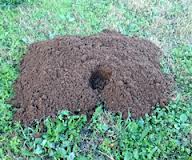Caller frequently ask if they have only one mole doing the damage in their lawn or can they have multiple moles living in the lawn. I think a recent message from a new user of Yard Gard Mole Deterrent (Named Bill) supplied an excellent answer. Bill stated that last year he paid an exterminator to trap what he though was one mole which was destroying his lawn; to his surprise the exterminator trapped 21 moles in his lawn. Bill also realized that trapping the animal is very labor intense. Yeas, moles will congregate and share their deep runway tunnels. So, for the question, “Can you have multiple moles feeding areas in your lawn?” The answer is Yes.
An interesting point; the mole’s runways are normally located from two to four feet deep in the soil, where the mole will share the use of these deep runways, but the mole will fight for and protect their feeding areas which are located near the lawn surface. Since the mole normally lives two to four feet deep in the soil, we would not know they are present except by the evidence of their digging activities. There are two ways you can tell if a mole is present; and both ways are the results of their digging activity. First, you will see the presence of mole when they come near the lawn’s surface to feed, since their food source is normally located near the lawn surface. While feeding, the mole travels just under the lawn’s surface, which breaks the roots of the grass, which in-turn leaves a raised area in the grass and the grass in the raised area is dying. The other way you see the mole has been in your lawn is the mole hill. Vibrations in the earth causes dirt to fall into the mole’s runway tunnels. Cars, trucks and trains are several sources of the vibrations. The mole cleans this excess dirt out of his tunnel by digging a short tunnel to the surface and pushing the excess dirt to the surface; creating the mole hill. When you see the raised run in the grass and mole hills in your lawn, you can be sure you have a mole situation.
Keep in mind, Yard Gard can cover the entire lawn area to protect all feeding zones located in your lawn, therefore, deterring all moles entering the treated lawn area. (Yard Gard is not labor intense, just spread it and let Yard Grad do the repelling of the animal.)
The working principle of Yard Gard is operant conditioning. In other words, wild animals do not reason or think about their situation; they simply react to their surrounding conditions, such as hearing a sound, or seeing or feeling a motion or seeing a light as well as smelling an unpleasant odor or tasting an unpleasant flavor in the soil. Yard Gard uses the senses of smell and taste to deter the mole. Wild animals have a far more enhanced sense of smell and taste than humans, you will not notice the smell of Yard Gard (which is pleasant to humans) but, the mole certainly does smell and taste it. Yard Gard creates a “No Mole Zone” extending from the surface of the lawn downward for one to two feet. The mole will not travel through the “No Mole Zone” therefore the mole is not comfortable in the Yard Gard treated area and will move on to other feeding grounds of untreated soil.
Questions about your pest animal situation, call Yard Gard Support at 1-855-665-3746.



0 Comments